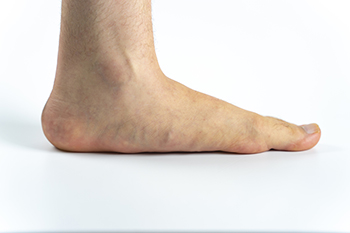Items filtered by date: January 2022
What Causes Adult-Onset Flat Feet?
It is not unusual for adults to develop flat feet as they age, even though they never had the problem before. Although this condition often affects only one foot, it sometimes occurs in both. Its main cause is changes to the posterior tibial tendon that limit its ability to lift the arch of your foot. Unfortunately, this dysfunction is progressive and usually worsens if not treated. Overuse of the tendon by walking, running, hiking or climbing stairs, is often the main cause. You may start to experience pain, swelling, a flattening of the arch and an inward rolling of your ankle. Eventually, the pain will increase, accompanied by swelling and redness. In the worst cases arthritis may develop. Several non-surgical treatments are available, including braces, orthotics, wearing a cast, and taking medication. In some cases surgery may be required. If you think you may be developing flat feet, it is suggested that you consult a podiatrist at your earliest convenience for a complete examination and to discuss appropriate treatment options.
Flatfoot is a condition many people suffer from. If you have flat feet, contact one of our podiatrists from Palmetto Podiatry Group of Anderson. Our doctors will treat your foot and ankle needs.
What Are Flat Feet?
Flatfoot is a condition in which the arch of the foot is depressed and the sole of the foot is almost completely in contact with the ground. About 20-30% of the population generally has flat feet because their arches never formed during growth.
Conditions & Problems:
Having flat feet makes it difficult to run or walk because of the stress placed on the ankles.
Alignment – The general alignment of your legs can be disrupted, because the ankles move inward which can cause major discomfort.
Knees – If you have complications with your knees, flat feet can be a contributor to arthritis in that area.
Symptoms
- Pain around the heel or arch area
- Trouble standing on the tip toe
- Swelling around the inside of the ankle
- Flat look to one or both feet
- Having your shoes feel uneven when worn
Treatment
If you are experiencing pain and stress on the foot you may weaken the posterior tibial tendon, which runs around the inside of the ankle.
If you have any questions please feel free to contact our office located in Anderson, SC . We offer the newest diagnostic and treatment technologies for all your foot and ankle needs.
What Causes Severe Pain Under the Big Toe?
Pain on the bottom of the foot just below the big toe is usually a sign of sesamoiditis, an inflammation of the two small bones under the first metatarsal. Repetitive weight-bearing activity (jumping or running, for instance), a change in footwear, or a gradually increased exercise regime are among the most common causes. You may feel a sharp pain to the affected area and react by cutting back or stopping the activity, getting different shoes, or possibly even limping. It can become very painful to walk on hard surfaces in bare feet. Causes include tissue injury, stress fractures of the sesamoid bones, or inflammation between the two small bones and the big toe (arthritis). High arches may be another culprit, causing more pressure under the ball of the foot. If you notice the pain growing more severe in this area of your foot, it is a good idea to make an appointment with a podiatrist who can determine the cause and offer appropriate treatment plans.
Sesamoiditis is an unpleasant foot condition characterized by pain in the balls of the feet. If you think you’re struggling with sesamoiditis, contact one of our podiatrists of Palmetto Podiatry Group of Anderson. Our doctors will treat your condition thoroughly and effectively.
Sesamoiditis
Sesamoiditis is a condition of the foot that affects the ball of the foot. It is more common in younger people than it is in older people. It can also occur with people who have begun a new exercise program, since their bodies are adjusting to the new physical regimen. Pain may also be caused by the inflammation of tendons surrounding the bones. It is important to seek treatment in its early stages because if you ignore the pain, this condition can lead to more serious problems such as severe irritation and bone fractures.
Causes of Sesamoiditis
- Sudden increase in activity
- Increase in physically strenuous movement without a proper warm up or build up
- Foot structure: those who have smaller, bonier feet or those with a high arch may be more susceptible
Treatment for sesamoiditis is non-invasive and simple. Doctors may recommend a strict rest period where the patient forgoes most physical activity. This will help give the patient time to heal their feet through limited activity. For serious cases, it is best to speak with your doctor to determine a treatment option that will help your specific needs.
If you have any questions please feel free to contact our office located in Anderson, SC . We offer the newest diagnostic and treatment technologies for all your foot and ankle needs.
Plantar Warts Can Be Treated!
Do Your Hiking Shoes Fit Correctly?
 Having shoes that fit correctly when hiking is very important because of the stress that is put on your feet. It is important to make sure that the hiking shoes are snug, but not too tight, and that the toes have room to wiggle. There are a few things that can be done in order to make sure hiking boots fit correctly when purchasing them. Because your feet tend to swell during the day, it’s a good idea to try on shoes either toward the end of the day or right after you exercise. Wearing the same socks and orthotics that will be worn with the shoes while hiking is also key in order to make sure you understand how the shoes will fit under those conditions. Shoes should also have a proper width to give the toes enough space, and there should also be enough space between the edge of the toes and the edge of the shoe. If you are unsure that your shoes fit properly, it’s suggested that you consult with a podiatrist who can examine your feet and offer expert advice.
Having shoes that fit correctly when hiking is very important because of the stress that is put on your feet. It is important to make sure that the hiking shoes are snug, but not too tight, and that the toes have room to wiggle. There are a few things that can be done in order to make sure hiking boots fit correctly when purchasing them. Because your feet tend to swell during the day, it’s a good idea to try on shoes either toward the end of the day or right after you exercise. Wearing the same socks and orthotics that will be worn with the shoes while hiking is also key in order to make sure you understand how the shoes will fit under those conditions. Shoes should also have a proper width to give the toes enough space, and there should also be enough space between the edge of the toes and the edge of the shoe. If you are unsure that your shoes fit properly, it’s suggested that you consult with a podiatrist who can examine your feet and offer expert advice.
It is important to find shoes that fit you properly in order to avoid a variety of different foot problems. For more information about treatment, contact one of our podiatrists from Palmetto Podiatry Group of Anderson. Our doctors will treat your foot and ankle needs.
Proper Shoe Fitting
Shoes have many different functions. They cushion our body weight, protect our feet, and allow us to safely play sports. You should always make sure that the shoes you wear fit you properly in order to avoid injuries and deformities such as: bunions, corns, calluses, hammertoes, plantar fasciitis, stress fractures, and more. It is important to note that although a certain pair of shoes might be a great fit for someone else, that doesn’t mean they will be a great fit for you. This is why you should always try on shoes before buying them to make sure they are worth the investment. Typically, shoes need to be replaced ever six months to one year of regular use.
Tips for Proper Shoe Fitting
- Select a shoe that is shaped like your foot
- Don’t buy shoes that fit too tight, expecting them to stretch to fit
- Make sure there is enough space (3/8” to ½”) for your longest toe at the end of each shoe when you are standing up
- Walk in the shoes to make sure they fit and feel right
- Don’t select shoes by the size marked inside the shoe, but by how the shoe fits your foot
The shoes you buy should always feel as good as they look. Shoes that fit properly will last longer, feel better, and improve your way of life each day.
If you have any questions, please feel free to contact our office located in Anderson, SC . We offer the newest diagnostic and treatment technologies for all your foot care needs.
Why Do My Heels Hurt?
If you are middle-aged, overweight, pregnant, stand for long periods of time, or wear shoes that offer little cushioning, you may be a candidate for plantar fasciitis. Other causes include, having flat feet, wearing ill-fitting shoes, running or jumping on hard surfaces, and having medical conditions, such as diabetes and arthritis. The plantar fascia is a band of tissue that connects the toes with the heels. When the plantar fascia is overstretched or bruised, the heel often bears the brunt of the pain. The pain is usually worse when you first get up in the morning, or after sitting or standing for long periods of time. There are a number of home remedies, such as icing the painful area, massaging your foot by rolling a golf ball under it, losing weight, and wearing heel pads in your shoes. However, if pain continues to increase, it may be wise to seek the opinion of a podiatrist who can examine the area, properly diagnose the condition, and suggest specific treatment options.
Plantar fasciitis can be very painful and inconvenient. If you are experiencing heel pain or symptoms of plantar fasciitis, contact one of our podiatrists from Palmetto Podiatry Group of Anderson. Our doctors can provide the care you need to keep you pain-free and on your feet.
What Is Plantar Fasciitis?
Plantar fasciitis is the inflammation of the thick band of tissue that runs along the bottom of your foot, known as the plantar fascia, and causes mild to severe heel pain.
What Causes Plantar Fasciitis?
- Excessive running
- Non-supportive shoes
- Overpronation
- Repeated stretching and tearing of the plantar fascia
How Can It Be Treated?
- Conservative measures – anti-inflammatories, ice packs, stretching exercises, physical therapy, orthotic devices
- Shockwave therapy – sound waves are sent to the affected area to facilitate healing and are usually used for chronic cases of plantar fasciitis
- Surgery – usually only used as a last resort when all else fails. The plantar fascia can be surgically detached from the heel
While very treatable, plantar fasciitis is definitely not something that should be ignored. Especially in severe cases, speaking to your doctor right away is highly recommended to avoid complications and severe heel pain. Your podiatrist can work with you to provide the appropriate treatment options tailored to your condition.
If you have any questions please feel free to contact our office located in Anderson, SC . We offer the newest diagnostic and treatment technologies for all your foot and ankle needs.




